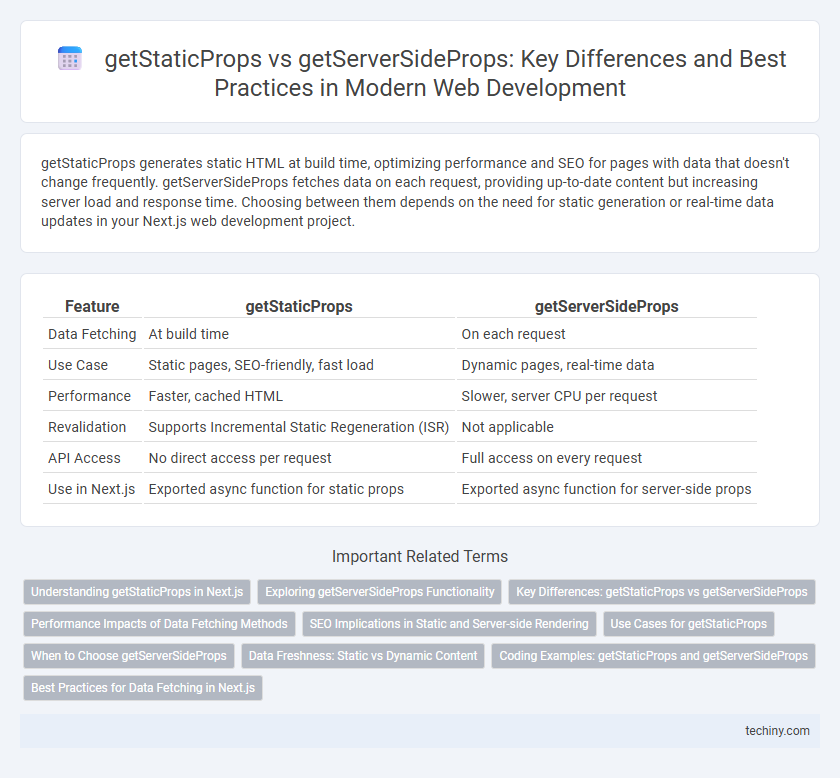getStaticProps generates static HTML at build time, optimizing performance and SEO for pages with data that doesn't change frequently. getServerSideProps fetches data on each request, providing up-to-date content but increasing server load and response time. Choosing between them depends on the need for static generation or real-time data updates in your Next.js web development project.
Table of Comparison
| Feature | getStaticProps | getServerSideProps |
|---|---|---|
| Data Fetching | At build time | On each request |
| Use Case | Static pages, SEO-friendly, fast load | Dynamic pages, real-time data |
| Performance | Faster, cached HTML | Slower, server CPU per request |
| Revalidation | Supports Incremental Static Regeneration (ISR) | Not applicable |
| API Access | No direct access per request | Full access on every request |
| Use in Next.js | Exported async function for static props | Exported async function for server-side props |
Understanding getStaticProps in Next.js
getStaticProps in Next.js enables static site generation by fetching data at build time, improving performance and SEO for pages with content that does not change frequently. It runs only during the build process, allowing pre-rendered HTML files to be served instantly without server delays. This method is ideal for blog posts, documentation, and marketing pages where data remains consistent across user requests.
Exploring getServerSideProps Functionality
getServerSideProps enables server-side rendering by fetching data at request time, ensuring dynamic content updated on every page load. Unlike getStaticProps, which generates static pages at build time, getServerSideProps makes the page responsive to user-specific data or frequently changing information. This method improves SEO and personalization by providing fresh content directly from the server on each request.
Key Differences: getStaticProps vs getServerSideProps
getStaticProps generates static HTML at build time, enabling fast page loads and better SEO by serving pre-rendered content, ideal for pages with data that changes infrequently. getServerSideProps runs on every request, fetching fresh data server-side and rendering the page dynamically, useful for real-time or frequently updated content. The key difference lies in timing: getStaticProps pre-renders once, while getServerSideProps renders per request, impacting performance and data freshness.
Performance Impacts of Data Fetching Methods
getStaticProps generates static HTML at build time, significantly enhancing performance by serving cached pages and reducing server load during user requests. In contrast, getServerSideProps fetches data on each request, providing real-time content updates but introducing higher latency and potential bottlenecks under heavy traffic. Choosing between these methods depends on the need for instantaneous data freshness versus optimal speed and scalability.
SEO Implications in Static and Server-side Rendering
getStaticProps generates static HTML at build time, enhancing SEO by delivering fast, crawlable pages with consistent content. getServerSideProps renders pages on each request, allowing dynamic, up-to-date content but potentially slowing page load and impacting SEO rankings. Choosing between these methods depends on the balance between content freshness and optimal SEO performance in static versus server-side rendering.
Use Cases for getStaticProps
getStaticProps is ideal for pages that can be pre-rendered at build time, such as marketing sites, blogs, or documentation where content does not change frequently. It improves performance by generating static HTML, reducing server load and enabling faster page loads for users. This method is best suited for SEO-critical pages and scenarios where data updates are infrequent or can be handled through static regeneration.
When to Choose getServerSideProps
Choose getServerSideProps when dynamic data must be fetched on each request to ensure up-to-date content, such as user-specific information, real-time updates, or frequently changing API data. This method offers server-side rendering on every page load, ideal for pages requiring SEO benefits while maintaining data freshness. Avoid getServerSideProps for static or rarely changing content to optimize performance and reduce server load.
Data Freshness: Static vs Dynamic Content
getStaticProps generates static content at build time, resulting in faster performance but serving data that may become outdated until the next build. getServerSideProps fetches data on each request, ensuring dynamic content with up-to-date information but can increase server response time. Choosing between the two depends on the need for data freshness versus performance efficiency in web applications.
Coding Examples: getStaticProps and getServerSideProps
getStaticProps enables pre-rendering of pages at build time with static data fetching, ideal for content that doesn't change frequently, while getServerSideProps fetches data on each request, supporting dynamic, real-time content. For example, getStaticProps can return props like `return { props: { data: await fetchAPI() } }`, generating HTML once per build, whereas getServerSideProps uses `export async function getServerSideProps(context) { const data = await fetchAPI(); return { props: { data } }; }`, ensuring fresh data on every request. Choosing between them hinges on the need for up-to-date content versus performance benefits from static generation.
Best Practices for Data Fetching in Next.js
getStaticProps enables pre-rendering pages at build time for faster load speeds and improved SEO, ideal for data that changes infrequently. getServerSideProps fetches data on each request, ensuring real-time updates for dynamic content but with higher latency. Best practices recommend using getStaticProps for static or less frequently updated data and getServerSideProps when dynamic, user-specific data is required, optimizing performance and user experience in Next.js applications.
getStaticProps vs getServerSideProps Infographic

 techiny.com
techiny.com